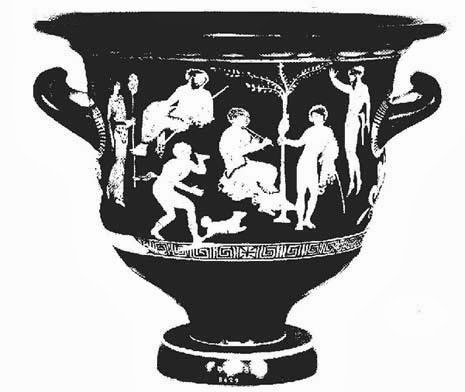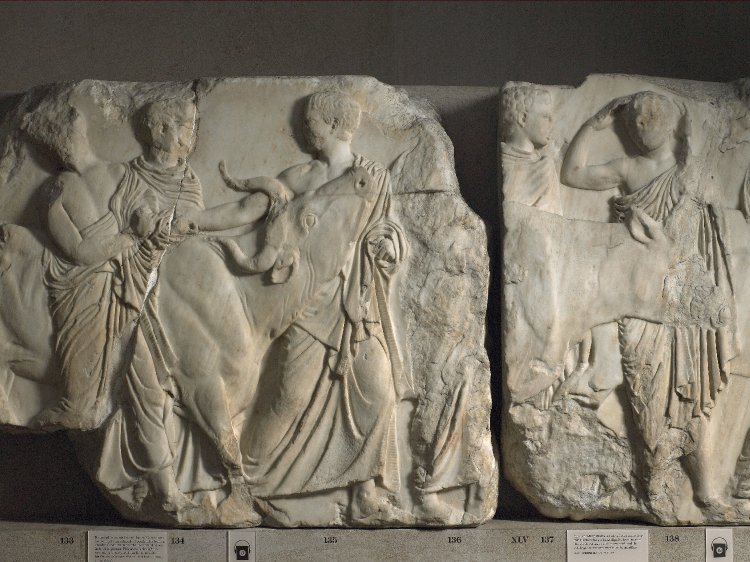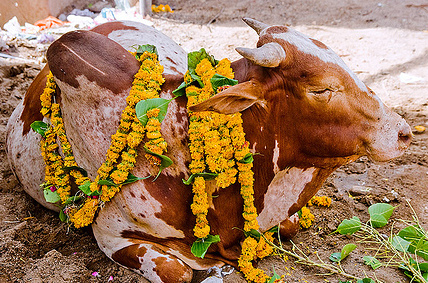Ode on a Grecian Urn1 |
|
ThouIn stanza one, . . . the urn is represented as both "historian" and poet, but the speaker cannot decode the "flowery tale" it tells, a readerly and writerly failure intensified [in] . . . stanza four. still unravish'dUnravished. It is someone or thing who has not been taken with force. It also means someone who has not had passionate sex. Keats calls the urn an "unravish'd bride" because of its innocent and pure qualities to him. bride of quietnessKeats is metaphorically saying the urn is married to quietness. He is actually saying the urn has remained untouched all these years.,
Thou foster-child of Silence and slow TimeThe urn has been raised in silence and slow time. This is the speaker saying the urn is very old and had not been disturbed. It has an original creator, the potter, so it is a foster-child of time because time is now its keeper.,
SylvanPertaining to or living in the woods; hence, a sylvan historian is one who records scenes in the woods. historian, who canst thus express
A flowery taleThe urn tells its story through images. Here "flowery" serves two purposes; it can mean excessive and elaborate, like the complicated and elaborate images on the urn. It can also be literal in the sense that the urn displays lots of greenery and blooms. more sweetly than our rhyme:In comparison, Keats tells his story through rhyme, or poetry. Keats feels the story is better told through the images on the urn than through his description.
What leaf-fring'dHere is more nature imagery, which reinforces the idea of the urn being a "Sylvan historian." This means the urn features rings of leaves around the urn. legend hauntsWhile this sounds quite ominous and often relates to the dead, "haunt" can also mean to frequent or be about. It refers to the legend. about thy shape
Of deities or mortalsThe speaker questions if the figures on the urn are godlike or human, or both. This shows how old the figures are if they are not recognized. Normally great figures are the ones immortalized on vases and urns but this urn is so old they have been lost in time., or of both,
In TempeA beautiful valley in Greece; it was sacred to Apollo, the god of poetry and music. or the dalesValleys. of Arcady?The literary word for Arcadia, an ancient Greece region in Peloponnesus. It is, by definition, an ideal rustic paradise. Arcady was very pastoral so the inhabitants lived simply. The name comes from the mythological figure Arcas, son of Zeus and Callisto. John Milton uses Arcady in several of his pastoral elegies.
What men or gods are these? What maidens loth?
What mad pursuit? What struggle to escape?2
What pipes and timbrels?Ancient tambourines.
 A timbrel, also called a tabret. What wild ecstasy?To be thrown into a frenzy or stupor. This can be caused by many emotions. Because the speaker questioned if they are fleeing or chasing, it could be either fear or joy.
A timbrel, also called a tabret. What wild ecstasy?To be thrown into a frenzy or stupor. This can be caused by many emotions. Because the speaker questioned if they are fleeing or chasing, it could be either fear or joy.
Heard melodies are sweet, but those unheard
Are sweeter;3
therefore, ye soft pipesThe pipes displayed on the urn. They're being played by the figures.
 Aulos is a type of pipe that is commonly shown on Greek urns. It looks like two pipes played together., play on;
Aulos is a type of pipe that is commonly shown on Greek urns. It looks like two pipes played together., play on;
Not to the sensual earThe ear of the senses, i.e., the physical ear on the speaker., but, more endear'dEndeared. This refers to the ear of the imagination; the ear where the speaker imagines the unheard melody,
PipePlay music. to the spirit ditties of no tone:Songs that have no notes or sounds. Because the speaker cannot hear the tune being played on the urn, he has to imagine it.
Fair youthThe beautiful young person playing the unheard music., beneath the trees, thou canst not leaveThe musician will never stop playing his song because he is frozen in time on the urn.
Thy song, nor ever can those trees be bare;Like the musician, this tree will not age or change season. It will always have leaves on the branches as it is portrayed in the image.
 An example of how trees appeared on greek urns.
An example of how trees appeared on greek urns.
Bold LoverThere is a male figure pursuing a woman, presumably because he likes her., never, neverBy repeating "never," the speaker is reinforcing the point that they cannot kiss. canst thou kiss,
Though winning near the goal—yetThe bold lover is near his goal—i.e. the woman—but can never reach it because they are frozen in time., do not grieve;
She cannot fadeHer beauty will not fade because it is preserved on the urn., though thou hast not thy bliss,
For ever wilt thou love,4
and she be fair!And she will be beautiful and young!
Ah, happy, happyA word is again repeated to reaffirm a point. This time it references tree boughs. boughs! that cannot shed
Your leavesThe trees are happy because their leaves will never shrivel and die., nor ever bid the Spring adieu;In the image on the urn, it will always be springtime. The concept of spring parallels the figures mentioned earlier because springtime is associated with youth and growth.
And, happy melodist, unwearièdThe musician is never tired.,
For ever piping songs for ever new;His songs never become repetitive; they seem new because they are not heard.
More happy love! more happy, happyhappyIt is repetitious. "Happy" is used six times in five lines. Think of hap, as in luck. love!
For ever warm and still5
to be enjoy'dThis refers to the bodies of the women. They will always be warm—alive—and can be enjoyed, either in company or sex.,
For ever pantingThe panting is their exhaustion from forever playing chase., and for ever young;
All breathing human passion far above,
That leaves a heartThis is talking about the speaker's heart, the person looking at this urn. high-sorrowfulFull of lament. and cloy'dAs a verb, to weary with excess of anything. As an adjective, clogged, overfilled.,
A burning forehead, and a parching tongue.6
Who are theseThe speaker now moves to a third scene of people leading a sacrificial animal to an altar.
 Here is an example of an urn scene that depicts figures traveling to a sacrifice. coming to the sacrifice?
Here is an example of an urn scene that depicts figures traveling to a sacrifice. coming to the sacrifice?
To what green altarThe altar is green from the flowers and garlands displayed on it., O mysterious priestThe speaker is not sure who the priest worships, as in what god or goddess he serves.,
Lead'stLead. thou that heifer lowingThe heifer, or a young female cow, is lowing or moaning.
 This is the slab from The Marbles that Keats saw. at the skies,
This is the slab from The Marbles that Keats saw. at the skies,
And all her silken flanksThe "silken flanks" are the cow's sides. with garlands drest?The heifer's sides are draped with garlands of flowers and leaves because it is a sacrificial animal destined for the gods.
 A cow draped in flower garlands.
A cow draped in flower garlands.
What little town by river or sea-shore,
Or mountain-built with peaceful citadelA strong fortress.,
Is emptied of its folkThe speaker now thinks about the empty town the people have left behind., this pious morn?A religious morning.
And, little town, thy streets for evermore
Will silent be;7
and not a soul, to tellNo one is there to explain the sacrifice.
Why thou art desolateEmpty or deserted., can e'erNever. The word should be pronounced similar to "air." return.
O Attic shape! The "attic" is in reference to Attica, a city in the central part of Greece where Athens is located. Athens was "the eye of Greece, mother of arts and eloquence." The "shape" is the shape of the body of the Grecian urn.
 A traditional urn shape.8
fair attitude!A graceful pose. The speaker is admiring the pose, or shape, of the urn. with bredeInterwoven, like a braid. Here it means the men and women seem to be connected like a braid or rope.
A traditional urn shape.8
fair attitude!A graceful pose. The speaker is admiring the pose, or shape, of the urn. with bredeInterwoven, like a braid. Here it means the men and women seem to be connected like a braid or rope.
Of marble men and maidens overwroughtTo be covered in. Here, the urn is overwrought with the marble men and women.,
With forest branches and the troddenTrampled. This refers to the weeds stepped on and crushed by the running figures of the urn. weed;
Thou, silent form!The still images of the urn. dost teaseTo pull apart, to bring us along. us out of thought
As dothDoes. While "doth" was word used in everyday language, it is hardly used today. eternity: Cold Pastoral!A beautiful rural scene common in poety. The scene is the "ideal" picture of the rustic countryside. This one is cold because it is made of marble.
 A traditional pastoral painting.
A traditional pastoral painting.
When old age shall this generation wasteThe speaker is talking about when his generation has all died.,
Thou shalt remainWhen the speaker's generation is gone, the urn and its marble figures will still be there., in midst of other woeOnce the speaker's generation is gone, the things they considered problems will die out as well. However, the next generation will have other problems, or "woe."
Than ours, a friend to man, to whom thou say'stTo whom you say.,9
'Beauty is truth, truth beauty,10
—that is all
Ye know on earth, and all ye need to know.'11
Notes
1. "Ode on a Grecian Urn" was composed in May 1819 and published in 1820. He was inspired to write the poem after reading two of Benjamin Haydon's articles. In "Ode on a Grecian Urn", Keats describes a traditional urn. There is no one urn that the poem is based on; Keats had seen several on display in various museums. They came together to form the described urn. There is a hand drawn sketch by John Keats that shows one side of the urn. Keats' love for mythology and history played a large role in the depiction (Colvin 422). While virginal yet ancient, it is a "sylvan historian" that tells a story. The urn is described as a traditional vase with leaves and three scenes of mortals and gods, though the narrator does not know the location of the images.
2. The figures are either running away from or chasing something, the speaker cannot tell. This only adds to the mystery of the figures.
3. This relates to the figures who are playing music on pipes and tambourines. A melody that is heard sounds sweet because the listener enjoys it. A melody that is unheard, like the one being played on the urn, is sweeter because the person seeing it imagines the most beautiful song.
4. "Bliss" is a cause for happiness or delight. This means "While you will not get to feel happiness from kissing, you will always be in love.
5. Here, "still" carries two meanings. First, the females are unmoving because they are frozen in the urn's image. Second, they are a still like an art piece.
6. Without his own love, the speaker feels deprived. It's like he's dying of thirst but instead of water he craves love.
7. The streets of their town will always be empty and silent because everyone has left to go to the altar.
8. From stanza two until this point, the speaker has addressed a different scene in each stanza: the musician and lovers, the leafy trees, and the heifer traveling to sacrifice. Here, the speaker again addresses the urn as a whole, speaking directly to it.
9. This quote is the advice from the urn to the future generations. As an ancient urn that has been around for centuries, the speaker feels it should offer wisdom.
10. This is the most important line of the poem and arguably the most remembered line from Keats. It stems from a line Keats wrote in a letter to Benjamin Bailey that said, "I am certain of nothing but the holiness of the Heart's affections and the truth of the imagination. What imagination seizes as Beauty must be truth" (Colvin 153). Keats also wrote about beauty in Endymion, "A thing of beauty is a joy for ever: / Its loveliness increases; it will never / Pass into nothingness" (Colvin 583). While the urn can maintain a temporary state of happiness in the images, it cannot do the same for Keats (Siemsen 6). However, the urn does provide perpetual beauty which can bring eternal happiness, or truth, to the viewer.
11. Keats' lines "all / Ye know on earth, and all ye need to know" speak about Keats' belief of an afterlife (Colvin 423). In his letters, Keats wrote about his belief of another life beyond earth where a soul could find eternal happiness.